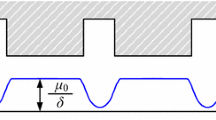A significant number of domestic and foreign studies in the field of electrical machines is devoted to the electromagnetic field in the stator slot of large AC machines, which determines the distribution of losses, heating, the range of acceptable operating modes of equipment, energy and performance indicators of the machine. At that, almost all the studies were based either on the use of analytical calculation methods, or on the analysis of the numerical field calculation in a two-dimensional statement of the problem. Assessment of the efficiency of the stator bars transposition was carried out in an approximate way due to the absence of possibility of an accurate spatial imaging of design features and physical processes. Currently, due to the active development of numerical calculation methods, automated finite element packages and a significant increase in the efficiency of computer equipment, it seems possible and relevant to simulate this problem in packages that allow it to be implemented in a spatial coordinate system (3D). In this study, the simulation was performed in the Ansoft Maxwell finite element package. In this article, the features of the version of four-stack winding bars with transposition in the stator slot part according to the “two by two” type and cross transposition are presented; the fundamentals of the problem statement of the magnetic field of alternating currents for the analysis of processes in the strands of the stator winding bars by the finite element method are considered; the results of the analysis of the magnetic field of alternating currents in the spatial problem statement in the stator bars of the considered type are presented; a quantitative analysis of the efficiency of the stator bars of the considered types in terms of losses in the stator slot part is performed.
Similar content being viewed by others
References
I. Z. Boguslavsky, “Selection of elementary conductors of the stator winding with incomplete transposition,” Élektrotekhnika, No. 4 (1981).
J. Haldemann, “Transposition in stator bars of large turbogenerators,” IEEE T. Energy Conver., 19(3), 553 – 560 (2004).
P. V. Oshurkov, L. M. Sliozberg, and E. M. Khutoretskii, “Experimental study of the effect of elementary conductors transposition on losses in the stator winding,” Élektrosila, No. 30 (1974).
V. V. Titov and E. M. Khutoretskii, Turbogenerators. Calculation and Design [in Russian], Énergiya, Leningrad (1967).
Yu. A. Bobkov, “Method for studying the transposition of the conductors of the stator winding rod according to generalized schemes,” Élektrichestvo, No. 8 (1987).
Author information
Authors and Affiliations
Corresponding author
Additional information
Translated from Élektricheskie Stantsii, No. 11, November 2022, pp. 46 – 51. https://doi.org/10.34831/EP.2022.1096.11.006
Rights and permissions
Springer Nature or its licensor (e.g. a society or other partner) holds exclusive rights to this article under a publishing agreement with the author(s) or other rightsholder(s); author self-archiving of the accepted manuscript version of this article is solely governed by the terms of such publishing agreement and applicable law.
About this article
Cite this article
Kadi-Ogly, E.F., Shuvaev, I.N. Simulation of Electromagnetic Field of Stator Winding Bars with Different Types of Strands Transposition. Power Technol Eng 57, 163–168 (2023). https://doi.org/10.1007/s10749-023-01637-2
Published:
Issue Date:
DOI: https://doi.org/10.1007/s10749-023-01637-2



